SwimSafer 2.0 is Singapore’s national water safety and swimming programme, developed by Sport Singapore and the National Water Safety Council to equip every child with essential water survival and swimming competencies. Designed as a progressive six-stage syllabus, it nurtures learners from their very first experience in the pool to confident, capable swimmers who understand how to stay safe in, on, and around water.
Each stage introduces a balance of practical swimming skills, personal survival techniques, and water safety knowledge. From floating, submerging, and basic propulsion at the early stages, to advanced entries, underwater skills, rescue awareness, and endurance swims in the higher levels, every step builds upon the last, ensuring students develop competence through structured learning and positive experiences.
Assessment in SwimSafer 2.0 combines practical performance and theory, encouraging students to apply what they have learned in realistic scenarios. Upon successful completion of each stage, learners receive an official national certificate issued through ActiveSG, a proud recognition of their achievement and progress toward full aquatic confidence and safety awareness.
At SPEEDISWIM, our certified NROC SwimSafer Coaches deliver this programme with passion, precision, and care. We provide a safe, engaging, and supportive environment where very child is guided to reach their potential at their own pace. Parents can trust that our lessons go beyond swimming — we cultivate resilience, discipline, and respect for the water.
The SwimSafer programme is administered through the Centralised Assessment Management System (CAMS), an official platform by Sport Singapore and Singapore Aquatics that ensures assessments are conducted fairly, safely, and consistently across Singapore. We are proud to announce that SPEEDISWIM at Orchid Country Club is officially recognised as one of the Non-ActiveSG SwimSafer CAMS Assessment Centres, effective October 2025. This recognition reflects our commitment to national-standard assessments and provides convenient access for schools and families in the North region to achieve their SwimSafer certification with confidence and care.

Stage 1 builds water confidence and safe behaviour in shallow water. The rationale is progressive readiness: master buoyancy, breath control, and orientation before distance or speed, so beginners stay calm and follow cues at all times.
Swim skills: Slide-in entry; face in water; blow bubbles; submerge to identify an object; front/back float 5sec and stand to recover; travel 10m front, 5m back; safe exit.
Survival skills: Without goggles and, when specified, in attire (T-shirts and shorts); signal distress floating on back; grasp a flotation aid; back float; scull or kick to safety and exit calmly; wear of PFD and jump inside the water, float for 30sec, exit the pool with PFD.
Swimsafer 2.0 Stage 1 Sequence
a. Swim sequence (with and without Goggles)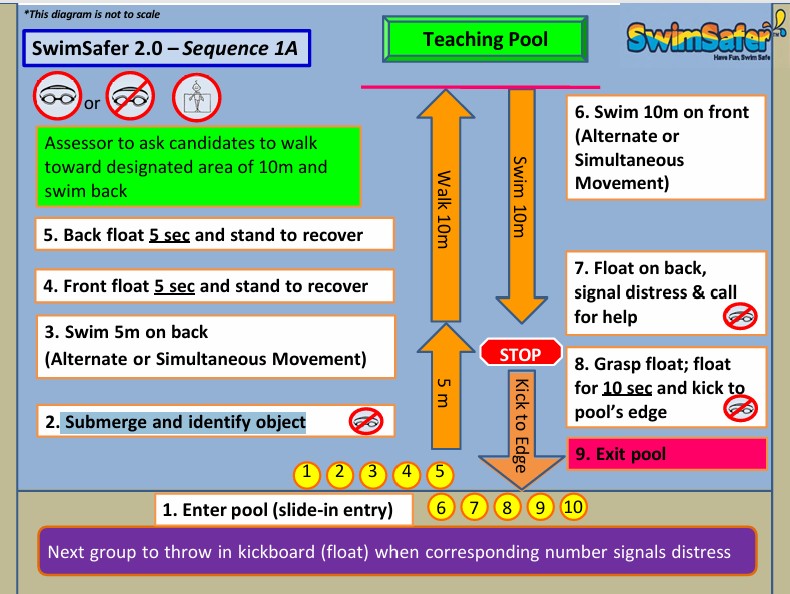
b. Survival sequence (without Goggles, with T-shirt & Shorts)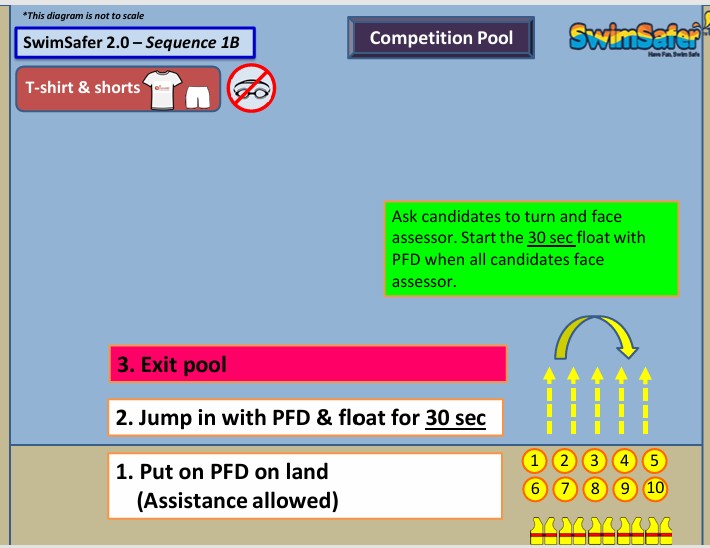
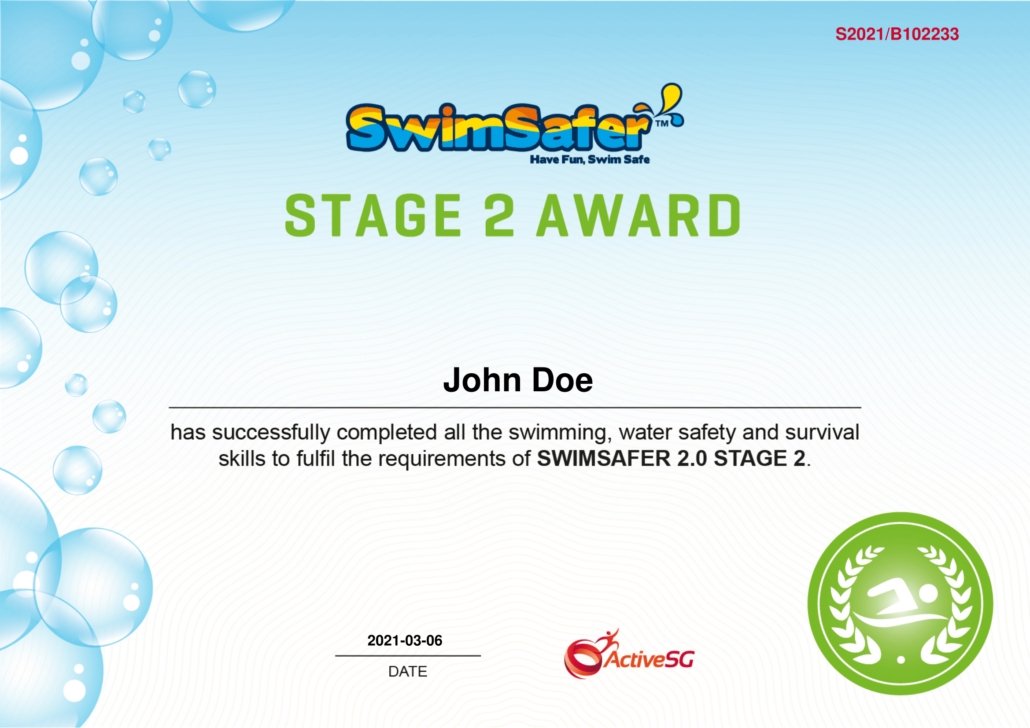
Stage 2 builds upon the Stage 1 foundation by developing independent competence through the connection of breathing, buoyancy, and coordinated movement. The goal is self-management in a chest-to-shoulder deep water environment.
Swim Skills: Step-in entry and exit safely; front float 10sec, swim 5m; back float 10sec, swim 5m; swim 25m front, 15 metres back; scull, float or tread 30 seconds; submerge calmly to recover object.
Survival Skills: Swim 15m survival stroke; wear a PFD and jump into 1.4m depth water to swim 25m confidently.
Swimsafer 2.0 Stage 2 Sequence
a. Swim sequence (with Goggles)
b. Survival sequence (without Goggles)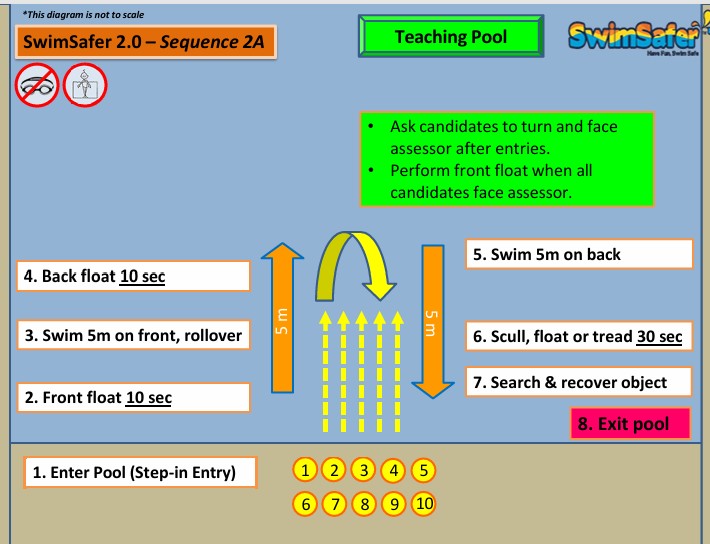
c. Survival sequence (without Goggles, with T-shirt & Shorts)
d. Survival sequence (without Goggles, with T-shirt & Shorts)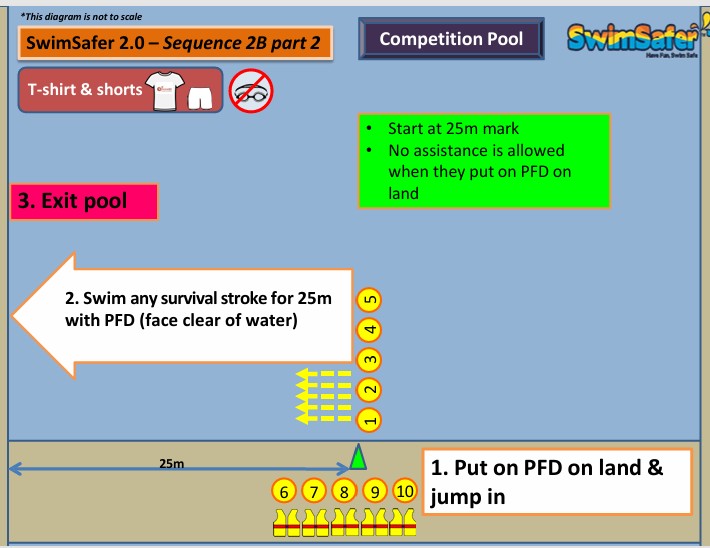

Stage 3 consolidates confidence into competence, with the ability to swim in deeper water. The rationale is progressive learning, building on buoyancy and breathing, to integrate efficient strokes, underwater control, and decision-making as a safe swimmer.
Swim skills: Slide-in entry; continuous 50m swim using 25m front crawl and 25m backstroke.
Survival skills: Stride/straddle deep-water entry; 25m breaststroke; 25m survival backstroke; scull/float/tread 50s; head-first scull on back 5m; surface dive and swim through submerged hoops of 2m apart, depth of 1.2m; wear PFD in water and swim 50m with PFD using any survival stroke.
Swimsafer 2.0 Stage 3 Sequence
a. Swim sequence (with Goggles)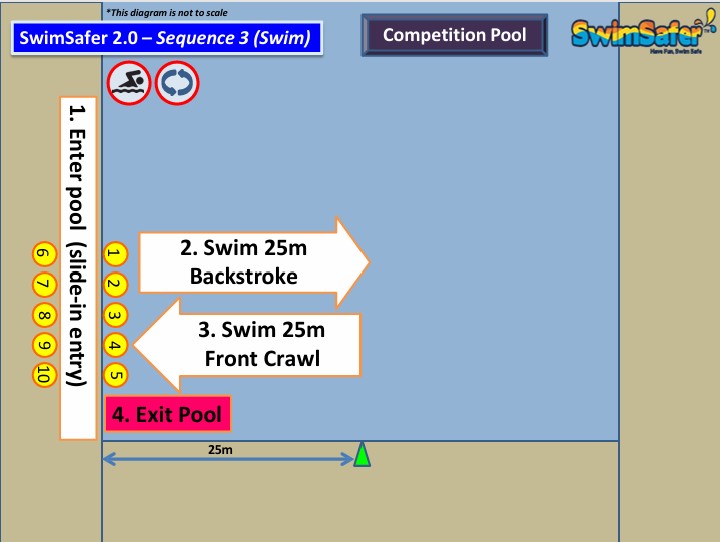
b. Survival sequence (without Goggles)
c. Survival sequence (without Goggles, with T-shirt & Shorts)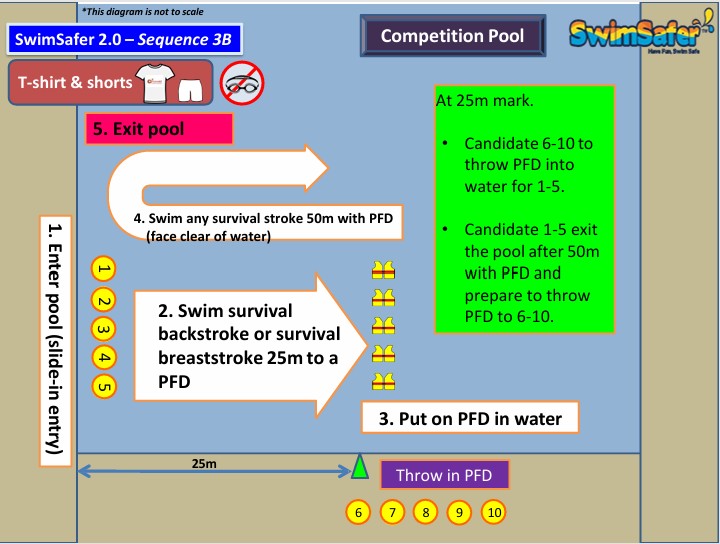
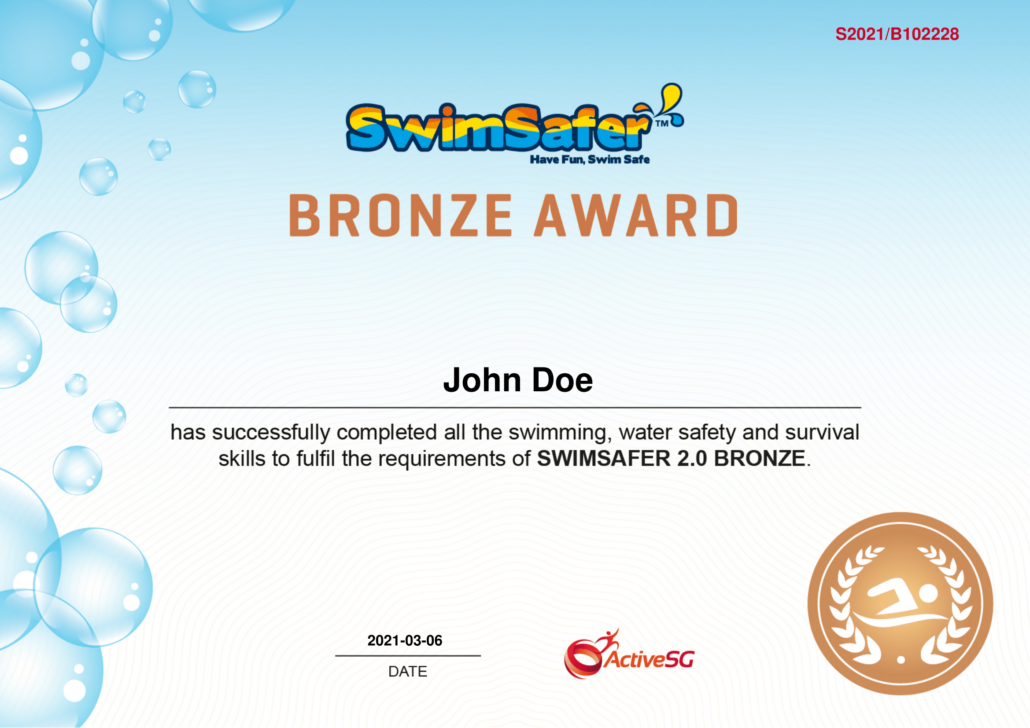
Stage 4 (Bronze) refines technique and deep-water confidence while introducing scenario-based survival skills. The rationale is efficiency under mild stress: swimmers learn to keep form, breathe rhythmically, and make calm decisions before distances increase in Stage 5.
Swim skills: Slide-in follow with continuous 100m swim using Backstroke, Front Crawl, Survival Backstroke, and Breaststroke, each 25m distance. Stroke mechanics are essential at this stage, with focus on streamlines, proper arms and legs movement, to achieve stroke efficiency.
Survival skills: Compact jump; forward somersault; 2min scull/float/tread water; feet-first surface dive and swim through hoops of 2m apart, depth of 1.4m deep; continuous swim using 3 survival strokes (Breast, Side and Back) for 3min changing stroke at 15m mark; ability to wave for help, grasp a floatation aid, swim to nearer point of safety and exit; performing a lifesaving drill by throwing floatation aid to victim, as a Rescuer.
Swimsafer 2.0 Stage 4 Sequence
a. Swim sequence (with Goggles)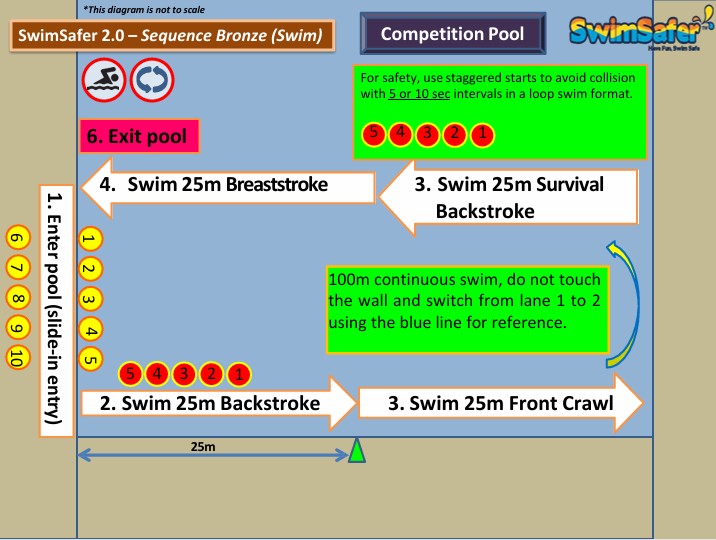
b. Survival sequence (without Goggles)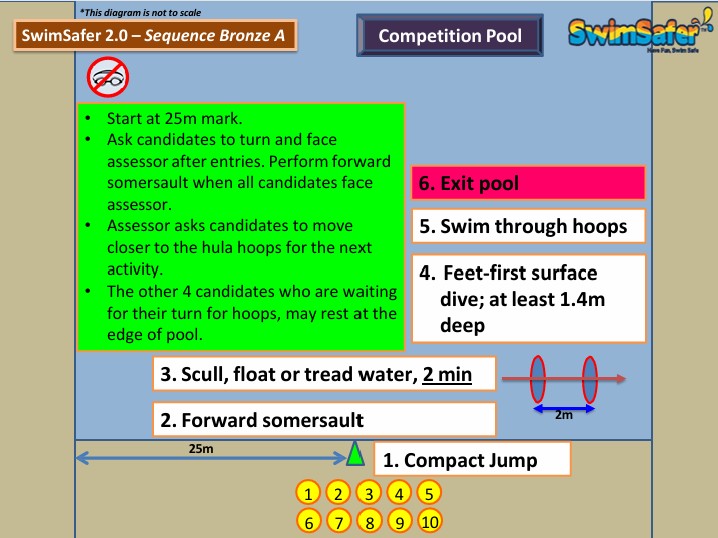
c. Survival sequence (without Goggles, with T-shirt & Shorts)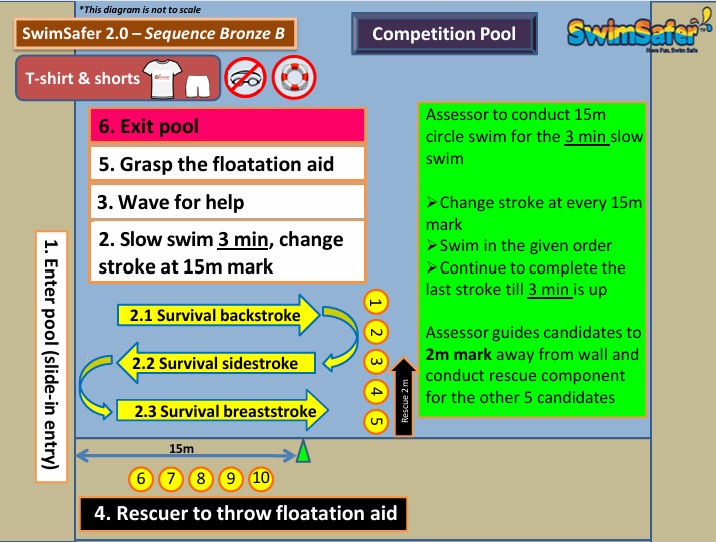

Stage 5 (Silver) develops intermediate deep-water competence with survival skills. The concept is to apply efficient techniques under pressure; the rationale is calm decision-making and energy conservation to sustain movement and assist to safety.
Swim skills: Crouching dive entry; speed swimming required for 50m each Front Crawl, Backstroke, Breaststroke, demonstrating the ability to swim fast, a byproduct of stroke efficiency; continuous 50m survival stroke swim (25m survival backstroke and 25m survival sidestroke); perform dolphin kick for a distance of 10m.
Survival skills: swim in clothing with long pants and t-shirt; demonstrate a Stride/Straddle jump; perform backward somersault; feet-first surface dives to a depth of 1.8m deep and swim through hoops with 3m apart; swim quickly using front crawl before signal distress by waving for help; put on a PFD in water; stay in a H.E.L.P. posture for 30sec; swim for 25m with PFD using one survival stroke (Back, Breast or Side) and exit with PFD; performing a lifesaving drill by throwing a PFD to victim, as a Rescuer.
Swimsafer 2.0 Stage 5 Sequence
a. Swim sequence (with Goggles)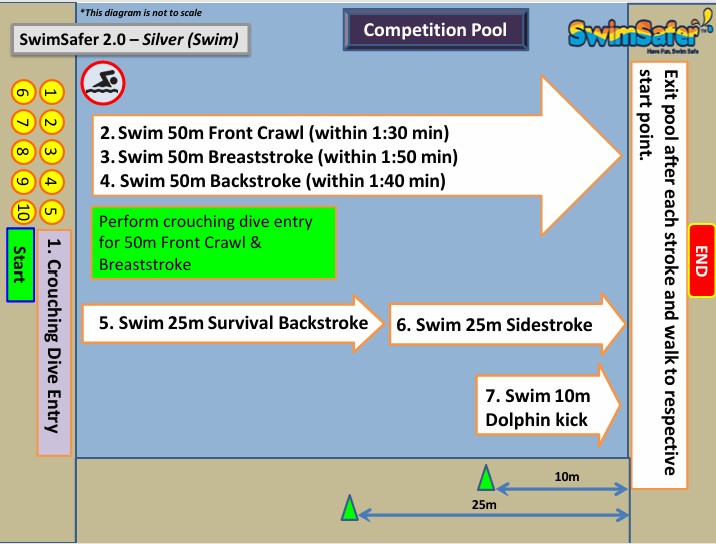
b. Survival sequence (without Goggles, with T-shirt & Shorts)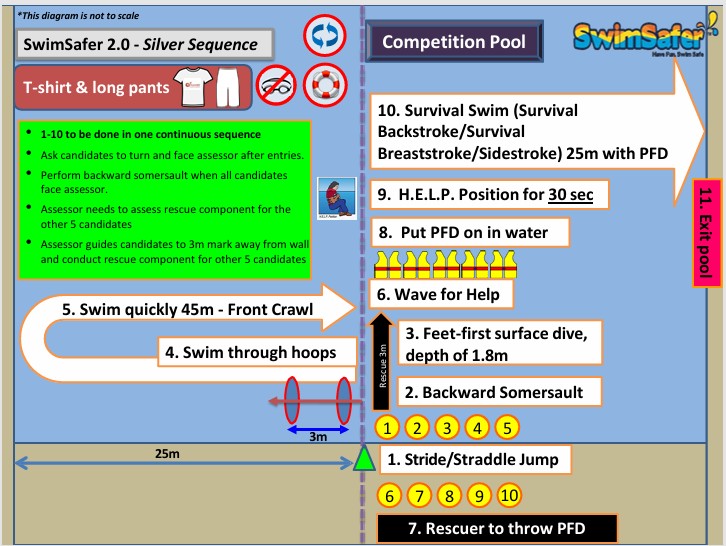
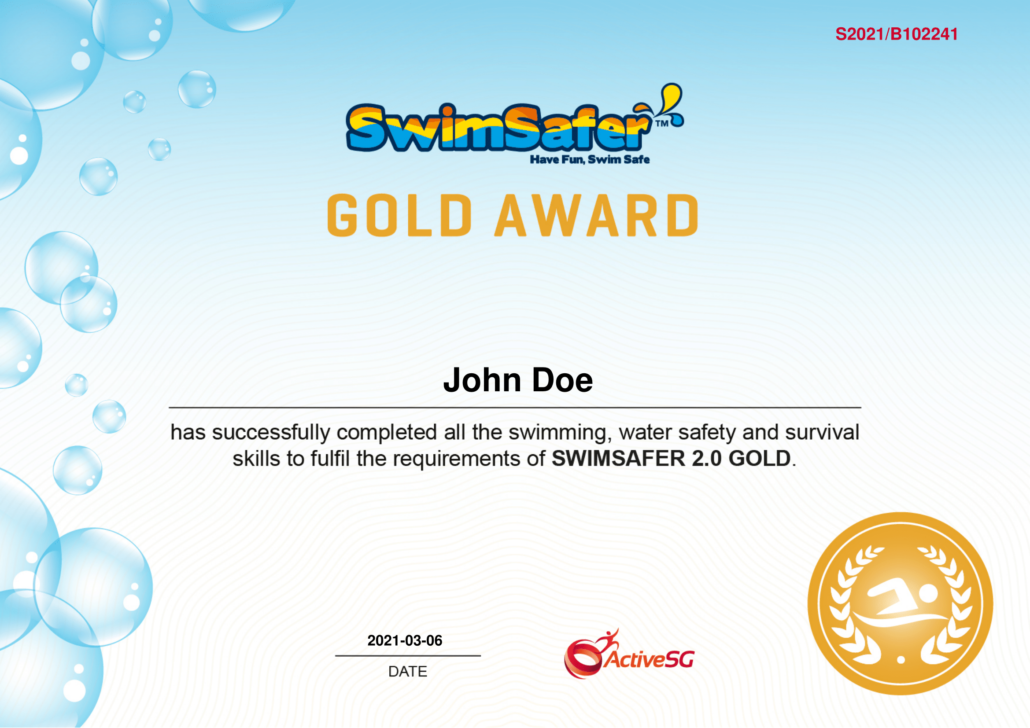
Stage 6 (Gold) is the final and most exciting stage of the programme! Here, confident swimmers will learn to stay composed, build endurance, and use practical survival skills in deep water. The assessment is a mix of advanced techniques and real-life scenarios, including a compact jump entry, a controlled head-first surface dive, underwater swim for a distance of 5m, making a float by removing pants as a survival tool, and swimming a survival stroke using the self-made float.
Swim skills: Standing dive entry, then 100m speed for Front Crawl, Breaststroke, and Backstroke with best form; 50m survival backstroke seamlessly into 50m sidestroke; 15m butterfly to graduate in style.
Survival skills: Compact jump; head-first surface dive to 1.8m depth, swim through hoops 5m apart; swim in attire (T-shirt & long pants): 50m front crawl and 50m survival stroke; craft a pants float, hold the H.E.L.P. posture for 1min, then complete a 25m survival swim with the float.
Swimsafer 2.0 Stage 6 Sequence
a. Swim sequence (with Goggles)
b. Survival sequence (without Goggles, with T-shirt & Shorts)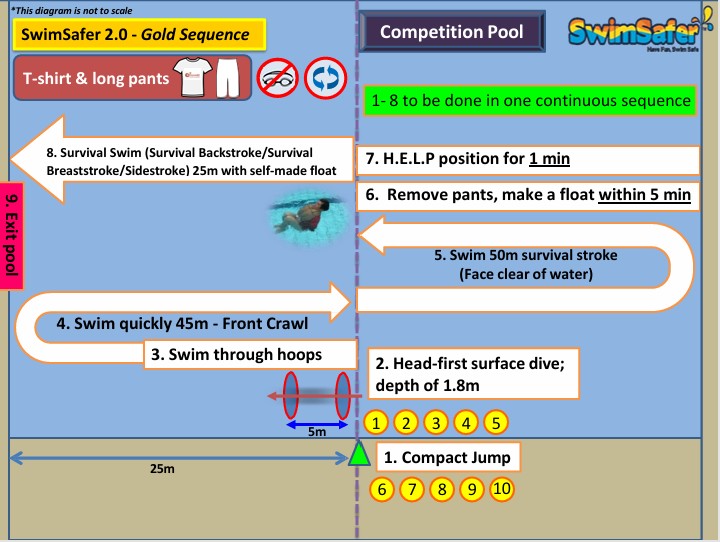
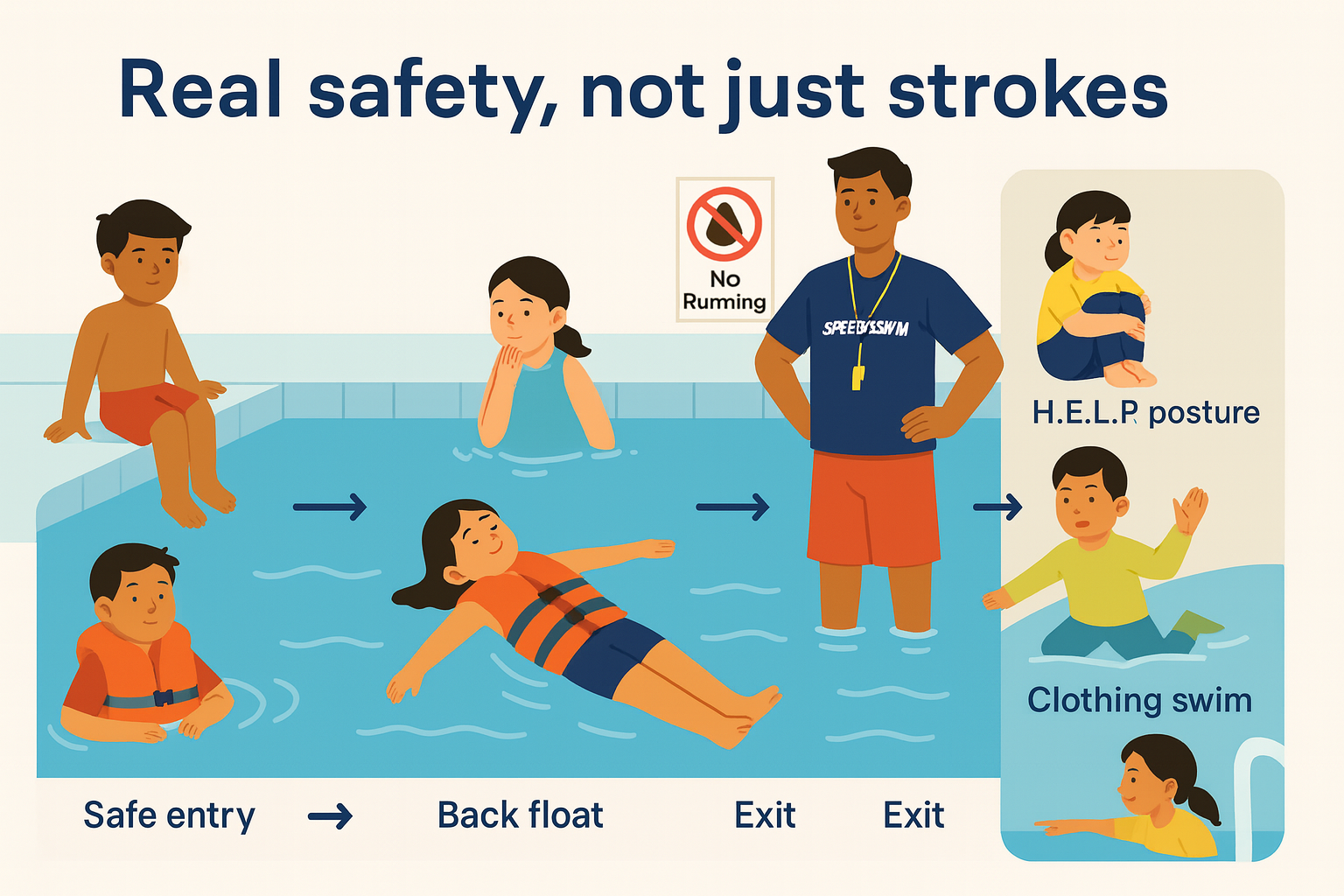
SwimSafer transforms basic swimming skills into comprehensive water safety capabilities. Children learn essential techniques such as safe entries and exits, breathing control, floating on both front and back, and calm recovery to prevent panic. They practice swimming in attire to understand clothing drag, learn the proper use of personal flotation devices (PFDs), and develop clear distress signaling skills. Additionally, they are trained in the H.E.L.P. posture to conserve body heat while awaiting assistance.
Through repetition, these skills become second nature, enabling children to remain calm, float, breathe, and move to safety in unexpected water situations. Parents gain confidence knowing their children are equipped with practical, age-appropriate skills, rigorously rehearsed and tested to build sound judgment and real-life preparedness.

Most parents seek objective progress for their child. SwimSafer's six stages precisely define the competencies children must demonstrate, ranging from initial water acclimation to advanced survival techniques. Each stage combines a practical assessment with an online safety quiz, culminating in a national e-certificate.
This structured approach motivates learners, guides coaches, and provides parents with clear milestones for celebrating achievement. When specific skills require development, such as calm submersion, sustained sculling, or proper PFD fitting, feedback is precise and targeted, ensuring efficient practice and fostering growing confidence. Furthermore, the systematic progression mitigates the risk of plateaus, as expectations incrementally increase across levels.
Families observe consistent improvement, replacing guesswork with tangible progress. Children gain a clear understanding of success criteria before assessment, which reduces anxiety while upholding high standards.
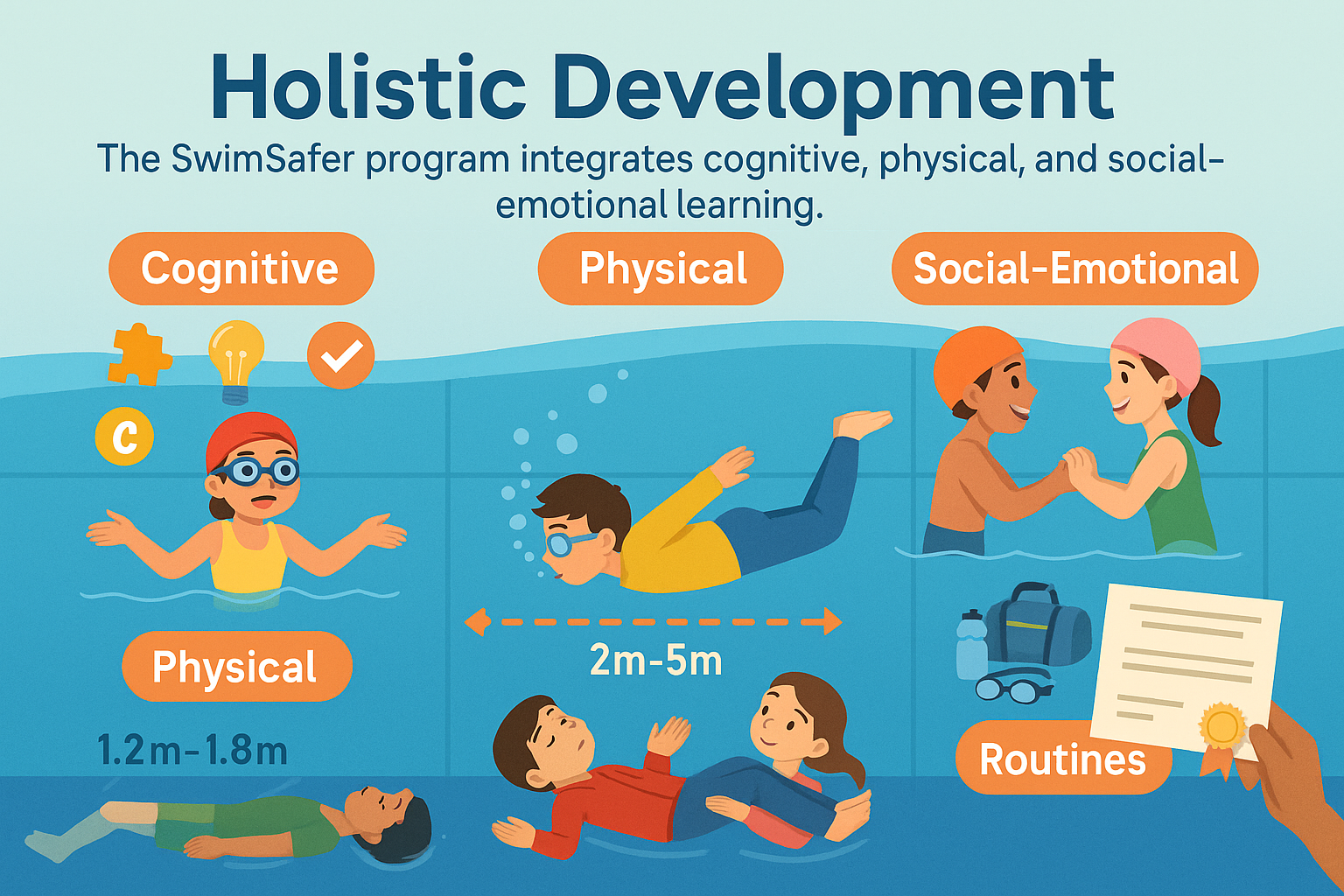
Holistic development of a child is fostered when cognitive, physical, and social-emotional learning are integrated. The SwimSafer program effectively merges these elements.
Physically, children develop posture, breath control, and functional strength through activities like floating, gliding, and propulsion. Cognitively, sequences, timing, and safety protocols enhance attention and decision-making skills. Emotionally, carefully structured yet supportive challenges, such as deep-water entries, swimming with clothing, and swimming underwater for a distance from 2m to 5m and depth of 1.2m to 1.8m, cultivate composure when facing difficult tasks and challenges. Socially, partner and peer activities encourage cooperation and effective communication.

The SwimSafer program equips your child with essential skills for safer aquatic adventures. Techniques such as calm entries, floating, and controlled breathing help build confidence in various water environments, from condominium pools to hotel lagoons. Skills like underwater orientation, submerging with open eyes, and gentle gliding prepare children for activities like snorkeling and basic skin diving. Sculling, treading water, and swimming with clothing on develop the stamina and composure needed for kayaking, dragon boating, and school camps.
The program also covers crucial safety protocols, including proper PFD fitting, distress signals, and the H.E.L.P. posture, which are directly applicable during boat trips and situations where a PFD is needed. Through sequenced practice and clear performance standards, children learn planning, pacing, and self-management.
This comprehensive approach develops young participants who can anticipate risks, conserve energy, communicate clearly, and enjoy a wide range of water activities, giving parents genuine peace of mind when supervising.